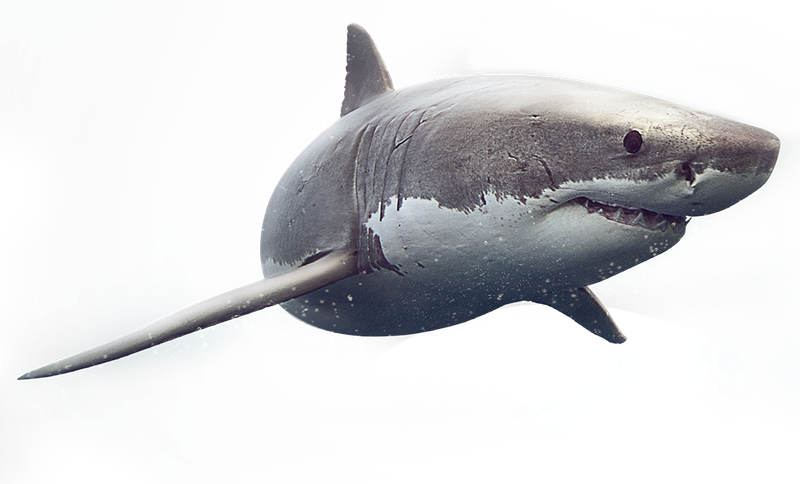Please note this exhibition is no longer open at the Australian Museum. Discover where this exhibition is touring here.
For 450 million years they’ve dominated Earth’s oceans.
Today, their existence has never been under more threat.
Submerge yourself in the world of Sharks! In this immersive blockbuster exhibition created by Australian Museum experts, visitors will go back in time to meet sharks’ ancient ancestors, come face-to-face with an 8m-long Whale Shark, and uncover their extraordinary adaptations with interactive displays, touchable specimens and objects from the AM collections. With cultural connections reaching back countless generations, visitors will discover how First Nations’ and Pasifika Peoples’ knowledge of sharks can help us protect them.
With rising temperatures, industrial fishing and oceans choked by pollution, sharks are in great danger. Our attitudes and our actions will decide the fate of these ancient survivors – do you dare to dive in?
Come on in, the water’s fine.
You’ll see...
- Life-size shark models ranging from 50cm Epaulette Shark to the 8m Whale Shark,
- Augmented reality interactives where you can play with a Whale Shark or explore the contents of a shark’s stomach,
- Real, touchable shark specimens from the Australian Museum collection,
- Plenty of jaw-some stuff for kids and families!
Exhibition highlights

Extraordinary adaptations
In your mouth, you have 16 teeth in one neat row. The White Shark has 300 teeth in five rows. Not so great for seals or dugongs, but very helpful to the shark, which can easily replace teeth lost while hunting and eating.
And do you know about sharks’ amazing skin? It’s not skin at all – they are covered in tiny denticles, which are closer to teeth than anything else! Sharks wear this suit of armour to protect themselves, and the hydrodynamic design makes them super fast.
You’ll see:
- The biggest fish – a life size model of a Whale Shark (Rhincodon typus), which can grow to up to 16m
- The fastest shark – a rearticulated skeleton of the Shortfin Mako Shark (Isurus oxyrinchus) which can reach speeds of up to 70km/hour and jump as high as 9m out of the water
- A wet specimen of the third-smallest shark – the Moller’s Lanternshark (Etmopterus molleri), reaching just 46cm long

Evolution
Four hundred and fifty million years ago, animals with a skeleton made from bone (bony vertebrates), and animals with a skeleton made from cartilage (cartilaginous vertebrates), separated for the first time. The bony vertebrates went on to become 90% of the planet’s animals – fishes, birds, mammals and humans. The cartilaginous vertebrates became sharks, chimeras and stingrays. Did you know sharks have survived five global mass extinctions since then?
You’ll see:
- A life size model of the 270-million-year-old Helicoprion, known as the buzzsaw shark
- Touchable fossils from the AM Palaeontology Collection
Image credit: Illustration of Akmonistion, an extinct shark that lived in the Early Carboniferous period. © Steve Wright.

Interactive experiences
The best way to learn about sharks is by dipping your toe into the water!
Interactive exhibits include:
- See with 360-degree Hammerhead vision: Having eyes at each end of the ‘hammer’ means they have 360° vision – they can see above and below them.
- Enter the Shark Tank: Dive into the diverse world of sharks in this digital, interactive, underwater vortex.
- What’s inside a Tiger Shark’s stomach? Lift the lid to find out. They do get very hungry...
- What sort of shark are you? Take our shark personality test to find out what kind of shark you would be.
- Adapt to survive: Use the touch screen to make the necessary evolutionary adaptations to survive in four different environments.

First Nations and Pasifika cultural representation
There are over 400 species of shark in the world, and about half of them occur in the waters around Australia, more than anywhere else. So we are uniquely placed to study sharks and create a better understanding of their importance.
Most First Nations and Pasifika Peoples have beliefs and cultural practices around sharks. In this exhibition we bring you just some of the people, places and stories about sharks from the great wash of the Pacific Ocean.
You’ll see:
- Cultural objects that teach us about the historical connections between people and sharks including weapons, armour, tools, ceremonial costume, drums and carvings.
- Newly acquired surfboards from Hawaii, made in the enduring style of Hawaiian Ancestors.
- An interactive seasonal calendar linking the plants and animals around you to what the sharks are doing in the water.
Image credit: Feeding the 'aumākua (ancestral spirits). © Original Artwork by Herb Kawainui Kāne LLC.
Sharks online publication
Delve into the world of Sharks and explore the digital publication with videos and extra content from the exhibition. Hear from First Nations peoples, scientists and conservationists as they share their stories about these ancient survivors.
Explore nowSharks is proudly supported by the NSW Government through the Blockbuster Funding initiative.
Exhibition Partner
Supporting Partners
Media Partner
The Australian Museum is COVID Safe
To help keep our staff, visitors and community safe, the AM has COVID-19 protocols in place, including physical distancing, increased cleaning and hygiene practices. Facemasks are encouraged.
View our full COVID-19 safety information here.




















